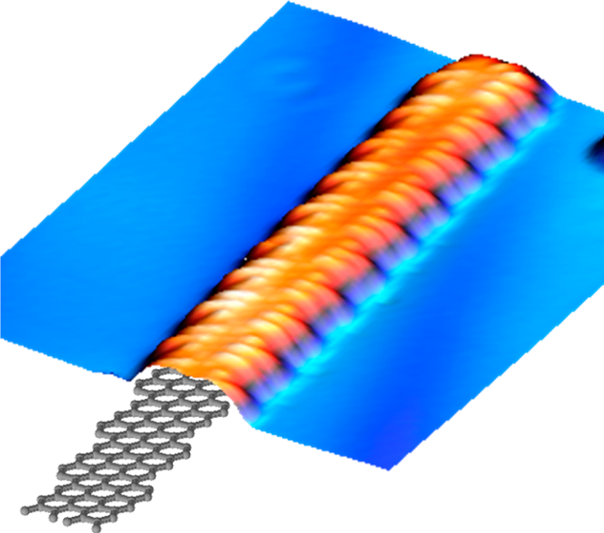Growing chiral graphene nanoribbons

Graphene nanoribbons (GNRs), are strips of graphene with ultra-thin width (<50 nm). Graphene ribbons were introduced as a theoretical model by Mitsutaka Fujita and coauthors to examine the edge and nanoscale size effect in graphene.
GNRs are very interesting structures, partly due to their attractive electronic properties. Those properties vary dramatically with changes in the nanoribbon’s atomic structure in terms of width, crystallographic symmetry, dopant heteroatoms, and edge termination. Moreover, the electronic properties can be modulated even further by the appropriate design of GNR heterostructures. This enormous tunability of electronic properties is thus extremely promising for next-generation nanoelectronic and optoelectronic devices.
However, the high susceptibility of those properties to minimum changes in the GNR structure also indicates the stringent need for atomic precision in GNR synthesis. With the advent of bottom-up synthesis, increasingly high hopes are being placed on this approach, but the field is still in its infancy. Actually, although a large pool of GNRs with different edge orientations, widths, or heteroatoms (and heterostructures) should be possible, only a few GNRs have been successfully synthesized with the required selectivity and precision so far.
![Figure 1. (a) Schemes of the chemical reactions of precursor 1 on various metallic surfaces. On Au(111) and Ag(111), it affords armchair GNRs. On Cu(111), it affords chiral (3,1)-GNRs. (b) Our work (highlighted with the red line) reports the transformation of reactant 2 into chiral GNRs independently of the substrate [Au(111), Ag(111), and Cu(111)]. Associated STM images are shown for poly-2 after initial polymerization by Ullmann coupling (5.6 nm × 2.2 nm, I = 0.09 nA, U = 1.5 V), as well as for the final (3,1)-GNR after cyclodehydrogenation (5.6 nm × 2.2 nm, I = 0.2 nA, U = −650 mV), both on Au(111). Steric hindrance causes poly-2 to be nonplanar. The high parts (circled in yellow) are correspondingly marked in the polymer’s wireframe structure above.](https://mappingignorance.org/app/uploads/2016/11/GNR-2-640x380.png)
polymerization by Ullmann coupling , as well as for the final (3,1)-GNR after cyclodehydrogenation, both on Au(111). Steric hindrance causes poly-2 to be nonplanar. The high parts (circled inyellow) are correspondingly marked in the polymer’s wireframe structure above.
The problem was that the careful consideration of the reactions involved indicate that this is a very system-specific reaction mechanism not translatable to other substrates, based on the surface-catalyzed, selective activation of particular C−H bonds.
Nevertheless, those results have inspired the work of a team coordinated by Dimas G. de Otayza, Ikerbasque professor working at DIPC and CFM (CSIC-UPV/EHU) and Diego Peña, from CIQUS and USC, that includes researchers from these institutions plus UPV/EHU, CIC nanoGune, and Yutaka Wakayama from MANA. The team reports in ACSNano1 that they have found a way of growing, independently of the substrate, chiral GNRs that are atomically precise.
Inspired by the system-specific growth of (3,1)-GNRs on Cu(111) from precursor 1, the researchers designed an alternative building block 2 (Figure 1) that renders the same (3,1)-GNRs but now independently of the substrate material. This has been proven on Au(111), Ag(111), and Cu(111), revealing additional advantages of the use of this monomer in the growth of selective and atomically precise GNRs, as is the substantially increased length of the resultant GNRs and the low processing temperature required for their formation.
Furthermore, the growth process has been followed in detail combining core level spectroscopy, scanning tunneling microscopy, and density functional theory calculations, providing a clear correlation between the spectroscopic fingerprints and the different reaction processes, as well as revealing the unusual absence of a metastable metal−organic intermediate preceding the covalent polymerization in the Ullmann coupling process on Ag(111).
The substantial GNR lengths achieved and the low processing temperature required to complete the reaction grant this reactant extremely interesting properties for potential applications.
Author: César Tomé López is a science writer and the editor of Mapping Ignorance
References
- Dimas G. de Oteyza, Aran García-Lekue, Manuel Vilas-Varela , Néstor Merino-Díez, Eduard Carbonell-Sanromà, Martina Corso, Guillaume Vasseur, Celia Rogero, Enrique Guitián, Jose Ignacio Pascual, J. Enrique Ortega, Yutaka Wakayama, and Diego Peña (2016) Substrate-Independent Growth of Atomically Precise Chiral Graphene Nanoribbons ACSNano doi: 10.1021/acsnano.6b05269 ↩